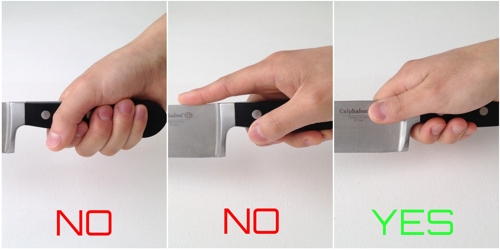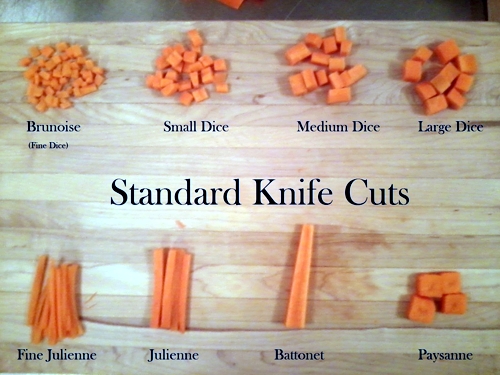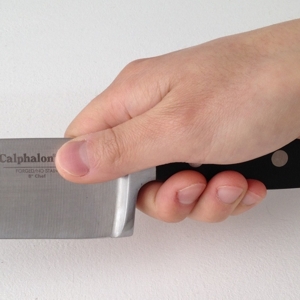Buying good quality chef knives and maintaining them properly is just part of the battle. You also have to know how to hold your knives and how to use them properly. This is the third jewel in your knife Skills Triple Crown! And only practice will make you the kind of precise and artistic cook you want to be!
 The Knife Grip Gospel according to Maggie: NEVER use the grip on the far left.
The Knife Grip Gospel according to Maggie: NEVER use the grip on the far left.
Some Culinary Arts instructors say the middle one is acceptable. I believe
that the grip on the far right is the only correct one. So there.
How you hold your knife and how you move it can make a big difference in how accurately and consistently you cut. It pays to take some time to practice the right way to do both!
How to hold your knife
Instructors at Culinary Schools may say there are several acceptable ways to hold your Chef’s knife. I only endorse one: Officially, it’s the Pinch Grip. I call it The Handshake. Just hold up your hand as if you’re about to shake with someone. Now grip your knife’s blade between your thumb and the side of your index finger just forward of the heel. Curl your index finger and the other fingers into your palm around the handle of the knife. By using this grip, you have maximum control over the position and movement of the blade. Also, you are gripping the knife at its point of balance, which will let you work with it longer before your hand or fingers get tired. It’s just the natural thing to do!
When cutting…
Use a stroking motion rather than a chopping one. This is easier on the knife’s wedge and gives you maximum control over the cut. Always try to get through whatever it is you’re cutting with one stroke. Otherwise you’re doomed to hack up the cut side of the food – and we all want to serve nice, smooth, clean-cut Means and Veggies, don’t we?
When cutting long, narrow foods across their waist – like when making Carrots Coins, for instance – use a rocking motion. Place the tip of your knife lightly on the board and rock the knife through the food. This results in a restricted slicing motion lets you maintain greater control over the stroke as well as the thickness and consistency of your Coins.
Don’t stab the tip of your knife into the cutting board. The tip is an important part of the blade and it should be as sharp and well-dressed as the centre portion or the heel. Use the tip to remove the hulls from Strawberries or the stems from Tomatoes. That kind of fine work is also good practice for your overall knife skills. Control is the key!
 The Classic French Culinary School Knife Cuts. Practice these every time you cook!
The Classic French Culinary School Knife Cuts. Practice these every time you cook!
Your overall knife skills will just naturally get better as a result!
Learn and practice the classic slices and dices. Slicing consistently really is a skill that takes practice. Not only do consistent slices and dices look good on the plate, having all the pieces of a given food the same size and shape ensures they’ll cook evenly. That’s important for a number of reasons, most of which should be self-apparent.
Special cuts should also be practiced. The most important may be the Fillet cuts – first, to cleanly remove the side of Fish from the rib cage and, second, to remove the skin without leaving too much precious flesh behind. This really is as much an art as it is a skill! If you want to do advanced knife work, start buying primal cuts of meat and practice cutting your own Roasts, Chops and Steaks. ‘French’ dress a rack of Lamb or two. Trim out a rack of Ribs from a full Pork Belly!
Get fancy, if you’re really into knife work. By that, I mean research and practice Food Sculpture. hat’s what the little figuring knife is for; the fine sculptural work! Like ice sculpting, Food Sculpting is a recognized specialty all on its own!
Take pride in your knife work!
All professional Chefs know that, when a plate comes to the table, their knife work is on display. And, since we eat first with out eyes, a beautiful plate is all part of the enjoyment of the meal!
Have fun and build your knife skills!
~ Maggie J.

